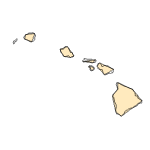Procambarus virginalis
(marbled crayfish)
Crustaceans-Crayfish
Cryptogenic |
|
Common name: marbled crayfish
Synonyms and Other Names: Procambarus fallax f. virginalis, marmorkrebs
Taxonomy: available through
www.itis.gov
Identification: Procambarus virginalis are directly descended from the P. fallax (Slough Crayfish) and there are therefore no known morphological differences between P. virginalis and female P. fallax, which can only be differentiated using genetic analysis (Vogt et al. 2018). Male P. virginalis do not exist, so any males can be assumed to be P. fallax, and likewise any all-female populations can be assumed P. viginalis. Closely related crayfishes can often be differentiated by differences in male gonopods. Because P. virginalis is a parthenogenic species consisting only of females, P. virginalis and P. fallax can be differentiated from P. alleni (Everglades Crayfish) by examination of the annulus ventralis where the female receives sperm. Procambarus alleni typically also lack the dark stripe on the side and have dark spots near the base of the antennae (Lyko 2017, Martin et al. 2010).
Size: Adults can reach about 13 cm (5 inches) in total length.
Native Range: There are no known natural populations of Procambarus virginalis, which originated in captivity. The presumed parental species, P. fallax (Slough Crayfish; Martin et al. 2010), is native to the Satilla River drainage in southern Georgia and south through peninsular Florida (Hobbs Jr. 1942).



|

Alaska |

Hawaii |

Puerto Rico &
Virgin Islands |

Guam Saipan |
Hydrologic Unit Codes (HUCs) Explained
Interactive maps: Point Distribution Maps
Nonindigenous Occurrences:
Multiple individuals have been found in the Lake Ontario drainage near Toronto, Ontario, Canada, and have been detected with eDNA. Populations of Procambarus virginalis are established throughout Europe and in Madagascar, and the species has also been reported from Japan.
Table 1. States with nonindigenous occurrences, the earliest and latest observations in each state, and the tally and names of HUCs with observations†. Names and dates are hyperlinked to their relevant specimen records. The list of references for all nonindigenous occurrences of Procambarus virginalis are found here.
Table last updated 12/18/2025
† Populations may not be currently present.
Ecology: Because P. virginalis does not have a native range, some of this section pertains to the parental species P. fallax. In its native range, Procambarus fallax is a habitat generalist, occurring in both flowing (lotic) and still (lentic) waters ranging from ditches to lakes and rivers where it is strongly associated with vegetation (Hobbs 1942). Although they do not typically construct burrows like some other crayfishes do, P. fallax will construct simple burrows down to near the water table to pass dry seasons (Hobbs Jr. 1942). They will “explore” during wet weather (Hobbs Jr. 1942). They can live in water with very low dissolved oxygen, and with pH below 5 (Hobbs 1942). They can live in the roots of floating plants such as water lettuce and water hyacinth (Hobbs 1942).
Procambarus fallax is a host to the bacteria Acinetobacter sobria, Citrobacter freundii, Grimontia hollisae, Pasteurella multocida, and Rickettsia-like organisms; the fungus Aphanomyces astaci (also known as crayfish plague); the Mesomycetozoea Psorospermium spp.; the branchiobdellid annelids Cambarincola floridanus, C. goodnighti, and C. manni; the ostracod Uncinocythere equicurva; unidentified mites (Arachnida); and unidentified coccidian and ciliate protists (Longshaw, in Longshaw and Stebbing 2016).
In Europe, P. virginalis can reach sexual maturity at between 14-22 mm carapace length (Hamr 2023).
Means of Introduction: The specimens in Ontario were most likely a released pet, as are those in Europe. In Madagascar they were released as a potential human food source. With their exponential reproductive rate they are common in the pet trade and are also bred for use as live food for fishes.
Status: A potential specimen was found in New York in 2023, identified morphologically from a photo. No more animals hve bee reported form the area, and the species is not known to be established in the United States. The species is a candidate for injurious listing in the United States, spring 2025.
Impact of Introduction: Summary of species impacts derived from literature review. Click on an icon to find out more...
Procambarus virginalis from two invasive populations in Germany as well as captive crayfishes tested positive for the crayfish plague pathogen (Aphanomyces astaci); although they are genetically resistant they are a carrier and therefore pose a risk to native European crayfishes if introduced (Keller et al. 2014).
Other Resources:
Hamr, P. 2023. First record of the marbled crayfish in Canada/North America. Int. Assoc. Astacology Crayfish News 45(1-2):1-3.
Hobbs Jr., H. H. 1942. The Crayfishes of Florida. University of Florida, Gainesville, FL.
Keller, N. S., M. Pfeiffer, I. Roessink, R. Schulz, and A. Schrimpf. 2014. First evidence of crayfish plague agent in populations of the marbled crayfish (Procambarus fallax forma virginalis). Knowledge and Management of Aquatic Ecosystems (414).
Lyko, F. 2017. The marbled crayfish (Decapoda: Cambaridae) represents an independent new species. Zootaxa 4363(4):544-552.
Martin, P., N. J. Dorn, T. Kawai, C. van der Heiden, and G. Scholtz. 2010. The enigmatic Marmorkrebs (marbled crayfish) is the parthenogenetic form of Procambarus fallax (Hagen, 1870). Contributions to Zoology 79(3):107-118.
Vogt, G., and coauthors. 2015. The marbled crayfish as a paradigm for saltational speciation by autopolyploidy and parthenogenesis in animals. Biology Open 4(11):1583-1594.
US Fish and Wildlife Service Ecological Risk Screening Summary for Procambarus virginalis
Author:
Jonathan Freedman
Revision Date: 7/15/2025
Citation Information:
Jonathan Freedman, 2025, Procambarus virginalis Lyko, 2017: U.S. Geological Survey, Nonindigenous Aquatic Species Database, Gainesville, FL, https://nas.er.usgs.gov/queries/FactSheet.aspx?SpeciesID=3656, Revision Date: 7/15/2025, Access Date: 12/18/2025
This information is preliminary or provisional and is subject to revision. It is being provided to meet the need for timely best science. The information has not received final approval by the U.S. Geological Survey (USGS) and is provided on the condition that neither the USGS nor the U.S. Government shall be held liable for any damages resulting from the authorized or unauthorized use of the information.